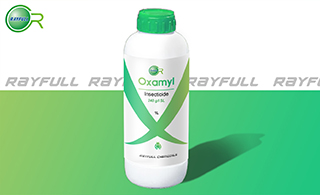Oxamyl
  杀线威 杀线威
Introduction: Oxamyl is used as an insecticide to kill and control a broad spectrum of insects, as an acaricide to control mites and ticks, and as a nematicide against roundworms. Its action is both systemic and contact. Oxamyl is used on field crops, vegetables, fruits, and ornamental plants. Oxamyl may be applied directly on plants or on the soil surface. Oxamyl belongs to a family of pesticides called carbamates. These insecticides work by blocking the normal functioning of cholinesterase, an essential nervous system enzyme.
Common name: Oxamyl
Another name:
Dioxamyl;Thioxamyl;2-Dimethylamino-1-(methylthio)glyoxal O-methylcarbamoylmonoxime; 2-(Dimethylamino)-N-(((methylamino)carbonyl)oxy) -2-oxoethanimidothioic acid methyl ester; etc.
Chemical name:
(EZ)-N,N-dimethyl-2-methylcarbamoyloxyimino-2-(methylthio)acetamide
Empirical formula: C7H13N3O3S
Structural formula:

Mol. Weight: 219.26 g/mol
CAS No.: 23135-22-0
Specifications
Leading Oxamyl supplier
Oxamyl 95% TC
Oxamyl 240 g/L SL
Oxamyl 10% GR
Packing:
BULK PACKING
Powder: 25kg/Bag, 25kg/Drum, 50kg/Drum etc.
Liquid: 200L/Drum, 20L/Drum, 10L/Drum etc.
SMALL PACKING
Powder: 1kg/Alu bag, 500g/Alu bag, 200g/Alu bag, 100g/Alu bag, 50g/Alu bag, 15g/Alu bag etc.
Liquid: 5L/Drum, 1L/Bottle, 500ml/Bottle, 250ml/Bottle, 100ml/Bottle, 50ml/Bottle etc.
Customerized packing label
Oxamyl FAO standard
Professional registration
HAZARDS IDENTIFICATION
Hazard statement(s)
H300 (100%): Fatal if swallowed.
H312 (100%): Harmful in contact with skin.
H330 (100%): Fatal if inhaled.
H411 (100%): Toxic to aquatic life with long lasting effects.
Precautionary statement(s)
P260: Do not breathe dust/fume/gas/mist/vapors/spray.
P264: Wash ... thoroughly after handling.
P270: Do not eat, drink or smoke when using this product.
P273: Avoid release to the environment.
P280: Wear protective gloves/protective clothing/eye protection/face protection.
P284: [In case of inadequate ventilation] Wear respiratory protection.
P301+P310: IF SWALLOWED: Immediately call a POISON CENTER/doctor/...
P302+P352: IF ON SKIN: wash with plenty of water.
P304+P340: IF INHALED: Remove person to fresh air and keep comfortable for breathing.
P312: Call a POISON CENTER or doctor/... if you feel unwell.
P320: Specific treatment is urgent (see ... on this label).
P330: Rinse mouth.
P363: Wash contaminated clothing before reuse.
P391: Collect spillage.
P405: Store locked up.
P501: Dispose of contents/container to.
Supplemental Hazard Statements: none.
MAMMALIAN TOXICOLOGY
Acute toxicity: 1) Acute oral LD50 for rats is 2.5 mg/kg 2) Acute dermal LD50 for rats is >2000 mg/kg. 3) Acute inhalation toxicity LC50 (4 h) for rats is 0.05 mg/L (nose only). 4) Skin irritation: Non-irritating to skin (rabbits). 5) Eye irritation: Non-irritating to eyes (rabbits). 6) Skin sensitization for guinea pig: Non-sensitizing.
NOEL: (2 y) for rats is 2 mg/kg/day, (2 y) for mice is 3.8 mg/kg/day, (1 y) for dogs is 0.93 mg/kg/day. Other Not carcinogenic. Not genotoxic.
ADI (JMPR) 0-0.009 mg/kg b.w. [2002]
Classification:
WHO Classification: Ib (Highly hazardous)
EC Risk Classification: T+ - Very toxic: R26/28; Xn - Harmful: E21; N - Dangerous for the environment: R51, R53
US EPA Classification (formulation): I (oral), II (inhalation), IV (dermal, eye) (Danger - Highly toxic, Warning - Moderately toxic, Caution - Not acutely toxic)
ECOTOXICOLOGY
Effect on birds: Acute oral LD50 for Mallard is 3.16 mg/kg. Effect on fish: Acute LC50 (96 h) for Rainbow trout is 3.13 mg/l. Effects on aquatic invertebrates: Acute EC50 (48 h) for Daphnia magna is 0.319 mg/l. Effects on algae: Acute 72 hour EC50 for Pseudokirchneriella subcapitata is 0.93 mg/l. Effects on bees: Contact acute 48 hour LD50 is 0.26 μg/bee, oral acute 48 hour LD50 is 0.38 μg/bee. Effects on earthworms: Acute 14 day LC50 is 112 mg/kg.
ENVIRONMENTAL FATE
EHC 64 (WHO, 1986; a review of carbamate insecticides in general). Animals In rats, oxamyl was hydrolysed to an oximino metabolite (methyl N-hydroxy-N',N' -dimethyl-1-thiooxamimidate) or converted enzymically via N,N-dimethyl-1- cyanoformamide to N,N-dimethyloxamic acid. Conjugates of the oximino compound, the acid, and their monomethyl derivatives constituted over 70% of the metabolites excreted in the urine and faeces (J. Harvey & J. C-Y. Han, J. Agric. Food Chem., 1978, 26, 902-910). Metabolism of carbamate insecticides is reviewed (M. Cool & C. K. Jankowski in "Insecticides"). Plants In plants, oxamyl hydrolyses to the corresponding oximino compound which, in turn, conjugates with glucose. Total breakdown into natural products has been demonstrated (J. Harveyet al., J. Agric. Food Chem., 1978, 26, 529-536). Soil/Environment Degraded rapidly in soil, DT50 c. 7 d. DT50 in groundwater (lab. study) 20 d (anaerobic), 20-400 d (aerobic) (J. H. Smelt et al., Pestic. Sci., 1983, 14, 173-181). Koc 25.
Usage: Oxamyl was introduced by E. I. du Pont de Nemours and Co. 'Vydate' was first sold in 1974. It is a soil-applied nematicide and insecticide used to control chewing and sucking insects on field and other crops.
Application: Biochemistry Cholinesterase inhibitor. Mode of action Contact and systemic insecticide, acaricide, and nematicide. Absorbed by the foliage and roots, with translocation Uses Control of chewing and sucking insects (including soil insects, but not wireworms), spider mites, and nematodes in ornamentals, fruit trees, vegetables, cucurbits, beet, bananas, pineapples, peanuts, cotton, soya beans, tobacco, potatoes and other crops. Phytotoxicity Non-phytotoxic when used as directed. Some strawberry varieties may be injured.
| 






